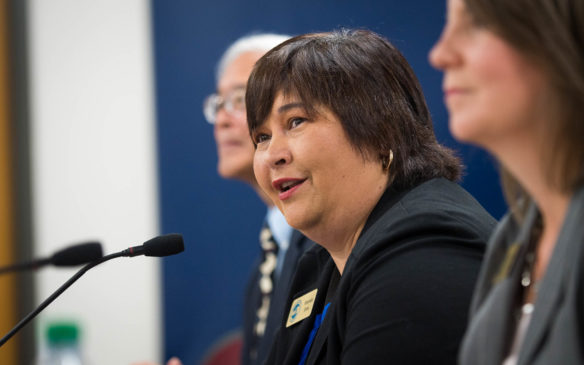
Associate Commissioner Rhonda Sims presents the proposed changes to the Kentucky Accountability System to the Kentucky Board of Education. Although the board originally was scheduled to consider the second reading of the proposed system at its Aug. 2 meeting, but action was delayed until later this month to give the board more time for discussion.
Photo by Bobby Ellis, Aug. 2, 2017
(FRANKFORT, Ky.) – The Kentucky Board of Education agreed to return to Frankfort later this month to vote on the regulation that will govern Kentucky’s new accountability system under the Every Student Succeeds Act (ESSA). Originally, the board was scheduled to consider the second reading of 703 KAR 5:270, Kentucky’s Accountability System, at its Aug. 2 meeting, but at the recommendation of Commissioner Stephen Pruitt, the board agreed only to review the item.
“One thing I don’t want to do is ever force you to make a decision that you are not comfortable with,” Pruitt said. “This is a big decision that will impact a full generation of students. So, we felt it was better for us to withdraw our request for a vote today, have a conversation, give you time to go back and process, ask questions, and talk to me about what you don’t understand or are not comfortable with.”
The accountability system has been under development for more than a year and involved thousands of Kentuckians, including teachers, administrators, parents and representatives from business and the community.
The model presented to the board includes six indicators for each grade level:
- Proficiency – measured by student performance on state reading/writing and mathematics assessments;
- Other academic indicator – measured by student performance on state science and social studies assessments;
- Growth (elementary and middle school only) – measured by the percentage of students who meet or are on track to meet their annual personal target for improvement based on an individual student trajectory toward proficiency in reading and mathematics; and for English learners, progress toward achieving English proficiency.
- Achievement gap closure – measured by awarding credit for reducing the gap in two ways:
- reducing the performance between a comparison group and reference group in the combined content areas of reading/writing, mathematics, science and social studies. The reference group is the highest performing racial/ethnic student group that represents at least 10 percent of the student population in a school; free/reduced-price meal eligible compared to non-free/reduced-price meal eligible; students with disabilities who have an Individual Education Program (IEP) compared to students without IEPs; and English learners compared to non-English learners.
- reducing the gap to proficiency in the combined content areas of reading/writing, mathematics, science and social studies by the following groups: White, African American, Hispanic, Asian, Native Hawaiian or other Pacific Islander, American Indian or Alaska Native, two or more races, free/reduced-price meal eligible, students with disabilities with IEPs, English learners, and a consolidated student group.
- Opportunity and access – measured by awarding credit for providing all students opportunities and access to:
- Rich curricula in visual and performing arts; health and physical education; science and social studies; career exploration including career and technical education courses, other courses that focus on essential skills and co-curricular learning and leadership experiences (middle school); career and technical education including specialized career pathways in state and regional high demand sectors as approved by the Kentucky Workforce Innovation Board and essential skills demonstrated as part of a Work Ethics Certification (high school);
- School quality as measured by a lack of chronic student absenteeism, behavior (student infractions involving drugs, weapons, harassment including bullying, alcohol, tobacco, assault-1st degree, other assault or violence and state resolutions not reported) and physical restraint and seclusion;
- Equitable access to federally defined student demographic groups in proportion to the school population to gifted and talented services; and at the high school level to advanced coursework including Advanced Placement, International Baccalaureate, Cambridge Advanced International and dual credit; and
- Whole child supports as determined by the school by selecting two of the following: school-based counselors or mental health services provider; school nurse; library or media specialist; family resource/youth services centers; or teachers with certification in visual art, music, dance, theater, media arts, physical education, health, world languages (middle school); cultural studies/world languages (high school); access to career counselors or career coaches (middle and high school).
- Within Opportunity and Access, each district and charter school shall propose to the department a locally determined indicator with a targeted goal or objective that is specific, measurable, achievable, relevant, and time bound. Through discussion and deliberation, the district or charter school and the department will agree on the goals or objectives of the locally determined indicator.
- Transition readiness – measured by awarding credit for the following criteria:
- At the elementary and middle school level, students meet or exceed the benchmark on a composite score that combines student performance on state-required assessments for reading/writing, mathematics, science and social studies. A composite score shall include the most recent content area assessment by grade level available for each school. Students participating in the Alternate Assessment Program will have criteria based on alternate assessment requirements.
- At the high school level, students who earn a regular or alternative high school diploma; and achieve academic readiness, career readiness, or military readiness:
- A school shall receive credit for each student demonstrating academic readiness by:
– Scoring at or above the benchmark score as determined by the Council on Postsecondary Education (CPE) on a college admissions examination;
– Completing six or more hours of department approved dual credit and receiving a course grade of B or higher;
– Completing two or more Advanced Placement courses and receiving a score of three or higher on the assessment;
– Receiving a score of five or higher on an examination for an International Baccalaureate Course; or
– Scoring at or above the benchmark on two or more Cambridge Advanced International examinations.
- A school shall receive credit for each student demonstrating career readiness by:
– Scoring at or above the benchmark on Industry Certifications as approved by the Kentucky Workforce Innovation Board on an annual basis; or
– Scoring at or above the benchmark on the Kentucky Occupational Skill Standards Assessment (KOSSA) as appropriate for articulated credit; and
– Completing six or more hours of department approved CTE dual credit, and receiving a course grade of B or higher; or
– Completing two credits in a career and technical education program of study and enrolling in a third credit in a CTE program of study;
– Completing a department approved or labor cabinet approved apprenticeship; or
– Completing a department-approved alternate process to verify exceptional work experience.
- A school shall receive credit for each student demonstrating military readiness by:
- – Scoring at or above the benchmark on Industry Certifications as approved by the Kentucky Workforce Innovation Board on an annual basis; or
- – Scoring at or above the benchmark on the Kentucky Occupational Skill Standards Assessment (KOSSA) as appropriate for articulated credit; and
- – Scoring at or above the department approved benchmark of the Armed Forces Quality Test (AFQT) on the Armed Services Vocational Aptitude Battery (ASVAB); and
- – Enlisting in a branch of military.
-
- For students who qualify as English learners in high school: Meeting criteria for English Language proficiency to be English Language Ready. Students participating in the Alternate Assessment Program shall meet criteria based on alternate assessment requirements and employability
- Graduation Rate (high school only) – measured by the 4-year and extended 5-year cohort graduation rate.
Each indicator will be weighted after a standards setting process, and then combined to produce an overall accountability determination of one to five stars, with an additional label for achievement gap closure or lack thereof. Schools with a significant achievement gap will earn a three star rating at the highest. If data cannot be calculated for an indicator, the weights shall be redistributed equally among the other indicators.
“Kentucky has high expectations for students and high standards for schools compared to other states,” said Brian Gong from the Center for Assessment. “I don’t know of any other state that has proposed achievement gap closure that is holding itself to the same high standard that Kentucky is.”
The board suggested several changes in the regulation, which department staff will address before bringing it back to the board for consideration.
At the Aug. 2 meeting, the board was scheduled to review four new regulations to guide the implementation of the first charter schools in the state. However, because of additional time spent on the accountability regulation, the board voted to defer considering the charter regulations until its special called meeting later in August. A date and time for that meeting will be announced.
After an overnight recess, the board will resume its meeting at 8:30 a.m. Aug. 3 at 8:30 with a meeting of the Joseph Kelly and David Karem Award Selection Committee. The board’s nominating committee will convene at the same time to discuss nominations for board leadership in the upcoming school year and recommendations for chair and vice-chair that the full board will consider.
The full board will meet starting at 9 a.m. ET and will be webcast at the department’s live meeting link.
Visit the board portal to access each day’s agenda and supporting materials online.



Leave A Comment